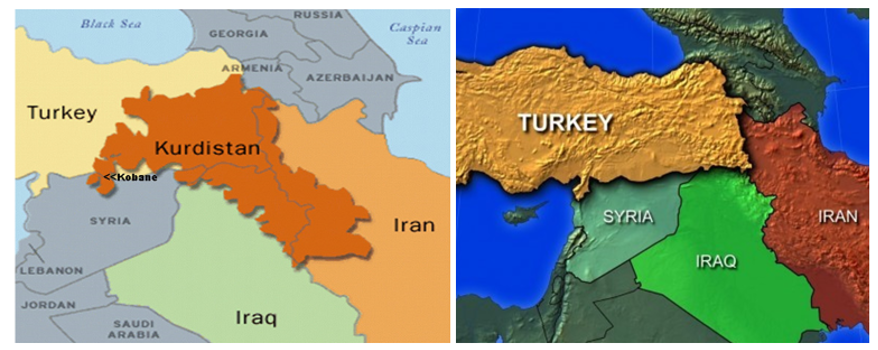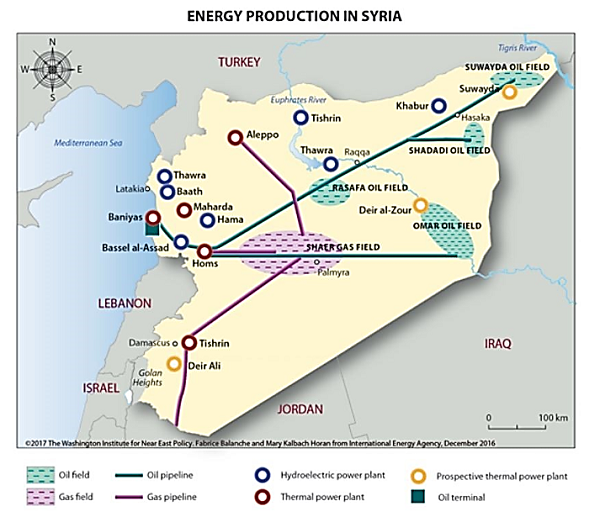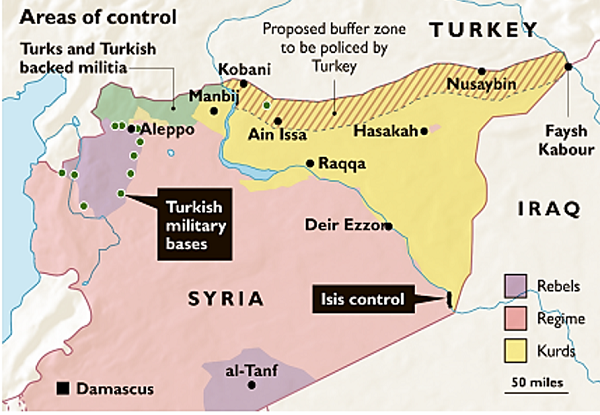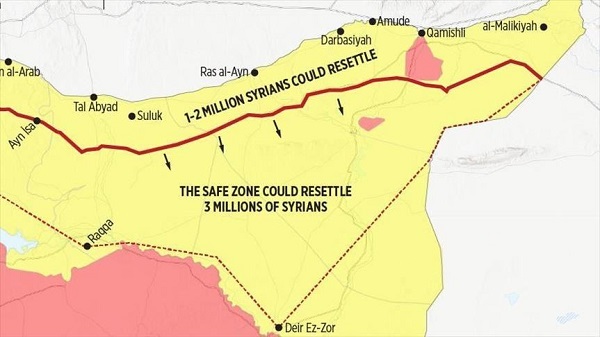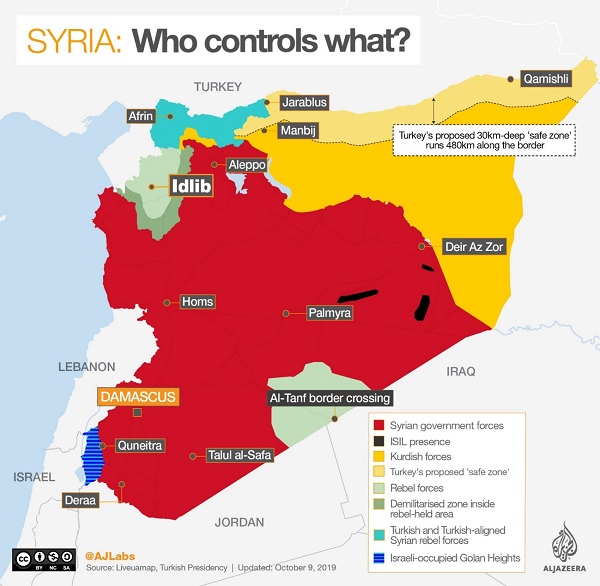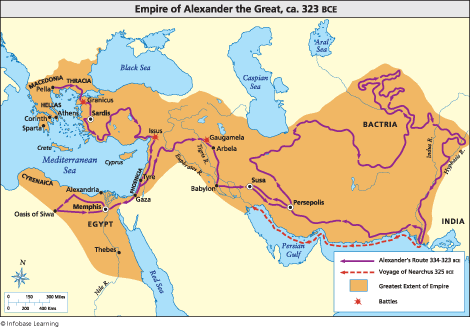The Middle East, Autumn 2019
In response, let me briefly sketch in some details. After World War 1, when Britain and France controlled the Middle East, the old Ottoman Empire was carved up among various tribal groups. This gave rise to the national boundaries we see in the whole region now. In the process, old Kurdistan was dissolved at the stroke of a pen and divided among Turkey, Syria, Iraq and Iran.as shown here.
The Kurds have been agitating for a homeland ever since and, as a result of their actions, have been accused of being “terrorists”. Turkey was particularly affected by their activity. In addition, since about 2000, the Turkish economy has been run 95% on natural gas and oil, but Turkey has none of her own. The closest is the region of North-East Syria. The problem is that this region of Syria, East of the Euphrates river, is where many of the Kurds have settled.
The Syrian Civil War broke out in 2011. The ruling families, including the Syrian President Assad, are Shiite Muslims. But they are only 20% of the population. The remaining 80% are Sunnis who were agitating for better conditions having been stirred up by the Muslim Brotherhood (based in Turkey). Turkey had hoped by this process to gain at least the Kurdish portion of the oilfields east of the Euphrates. Assad then released political prisoners into the population and then claimed that everyone who opposed him (the Sunnis) were all terrorists, including the Kurds. Because of the Kurdish problem, both Turkey and Syria were fighting against ‘terrorists’. Note, however, that Turkey wanted the overthrow of Assad, and still does. To that end Turkey supported ISIS and Al Qaeda who tried to set up a “Caliphate” in northern Syria & Iraq. Turkey actually stated that once ISIS was successful, Turkey would move in and take over the area. The ISIS head (Al Baghdadi) had protection in a Turkish village on the Syrian border. But the emergence of ISIS brought the USA into the mix to fight them. Because ISIS needed the oil to keep their finances going, they were concentrating on central and NE Syria, where the Kurds had control of the oil. The Kurds allied with the USA to defeat ISIS and frustrate Turkey’s plan to use ISIS to gain control of that area. Concurrently, when he was close to actually being overthrown, Assad called for Russia and Shiite Iran to assist him. Assad gave both of them 50-year leases on ports and airfields, as both nations wanted Mediterranean ports to export oil & gas from instead of their current complicated supply lines to the western nations. Both had been trying to establish a land “corridor” to the Mediterranean and Syria was the key country in that process. In January of 2018, Assad ceded all Syrian oil and gas fields to Russia. Russia tried to get the huge Omar fields near Deir Ez-Zor, but lost 200 men in their attack against USA and Kurdish forces. When the US finally defeated ISIS, Turkish plans for owning the oil and gas and controlling the region looked like failing, as did similar Russian hopes. Turkey then proposed a safe-zone in the Kurdish region East of the Euphrates in line with the old Adana agreement with Syria in 1998. Turkey aims to include that whole region East of the Euphrates, as this map issued by the Turkish Government controlled Anadolu Agency reveals.
In this area, the Turks would settle 3.6 million refugees and dilute the Kurdish population. But the initial part of the plan only required a strip 30 km or so wide. Because of Turkish threats to kill US troops as they swept through, the USA withdrew the 50 troops in the region of the strip, which gave Turkey access to the area. Russia had also agreed to oversee the movement of Kurds from the region. While Turkey and Russia were thus concentrating their military efforts on matters relating to the strip, the USA special forces went in unhindered by them to the border village and killed the ISIS leader. Meanwhile the US strengthened defenses around the Omar facilities against Russia & Turkey. Because it is in the safe-zone, the Suwayda fields in the NE corner of Syria are now under Turkish control. It may be wondered how this all lines up with the Bible. First, because of its agreements with Syria, Russia has huge port and airfield facilities in western Syria. To maintain this, there is effectively a Russian ‘safe-zone’ there. In addition, it has set up facilities throughout the Syrian government-controlled areas. Nothing happens without Russian approval. Israeli authorities have stated they now have a border with Russia, not Syria. Second, the Iranians have control over a large area of southern Lebanon through their proxies the Hezbollah, as well as in southern Syria near the Jordan border and the Golan heights next to Israel. Iran is rapidly increasing its nuclear capabilities at home, and have distributed cruise missiles to Lebanon, southern Syria and Yemen which can all strike Israeli targets. Third, the Hezbollah have 150,000 rockets aimed at Israeli facilities so that when the moment comes, Israel will be immobilized by the bombardment. Iran is shipping to, and manufacturing components in, Lebanon & Syria which make these rockets ‘smart’ and accurate to within 10 yards or so. This third development, coupled with the others, indicates that Isaiah 17 is getting close. This is particularly the case since Israel National News reported on 31st October 2019 that military officials are advising the Israeli government that it may be advisable to intervene in the Syrian scenario now Turkey has effectively moved its border south and east. The first two items also indicate that the events are in train to set up the Ezekiel 38 battle with Russia and Iran invading Israel. That, too is to gain the huge oil reserves that Israel has found in the Golan and the gas reserves in the Mediterranean nearby. In fact on the 4th November, 2019, it was announced that an additional 1 trillion cubic feet of gas had been found by Israel at the Karish field in the Mediterranean off the Israeli coast. Europe has contracted to take this oil and gas in a 2000 km pipeline from Israel rather than trade with Russia or Iran. For that reason, Russia and Iran will come against Israel to get control of the supply.
Finally, the Turkish situation. This must be seen in the context of Daniel 8 & 11. There we are informed that the Antichrist, the “man with the fierce countenance” will be the “king of the north” from the break-up of Alexander the Great’s Empire. When Alexander died, his kingdom, shown on Map 6, was divided among his 4 generals.
General Ptolemy took the south, namely Egypt and North Africa with Alexandria as the capital. General Seleucus took the northern part of the kingdom. The infighting among the generals saw the Arsacids form the Parthian Kingdom of Persia (which included Babylonia) in the East. This left the Seleucid Empire in the North comprising what is now Syria & Iraq, with its heartland being Turkey and a capital at Antioch as in Map 7. The 4th general took Macedonia and Greece in the west. (That is not shown below)..
As the King of the North in Daniel 11:21-45, Antichrist must be a ruler from the lands of the old Seleucid Empire, and also command a large army. The Syrian and Iraqi armies are small, but Turkey has the largest army in NATO next to the USA. In fact, apart from the USA, Turkey’s army is larger than all the rest of NATO put together. Given the correctness of this analysis, Daniel 8 says that Antichrist becomes strong “towards the south and towards the east” (Daniel 8:9). Turkey has gained the south in presently controlling the area near Afrin, Idlib & Aleppo, as in Map 5. It is now positioning itself to gain control of the whole area of Syria east of Euphrates, as in Map 4. When that happens, Turkey will be ready to assume power in the Mid-East. To some, this seems strange as they expect Turkey to come with Russia and Iran in Ezekiel 38 and be destroyed. The bond between Turkey, Russia and Iran is not robust. Turkey is following an independent line. Thus, it was stated that getting the US out of Syria was the aim of Turkey, Russia, & Iran. But now the Turkish desire to project their aims in northern Syria comes into direct conflict with the Russian and Iranian support for Assad, as the Turks desire to overthrow him. That is stated under the heading ‘Joint Patrols’in this article: Since the most ancient LXX version is the closest to the original, then we should consider the option that it is the merchants of Chalcedon who are among those saying to Russia and Iran “have you come to take spoil?” Since Chalcedon was the old trading center known today as Istanbul, (see Map 8) this may need a re-assessment of Turkey’s involvement. This could particularly be the case as a powerful Jewish discussion in the 1980’s pointed out that Turkey was not the ‘house of Togarmah from the far north’ in Ezekiel 38:6. Rather that referred to the Turkoman republics south-east of Russia, like Turkmenistan, Uzbekistan, Khazakstan, etc or the “Stans” generally. They are the colored areas on Map 9. If these points are valid, it may help explain the independent line being taken in northern Syria by Turkey against Russia, and the unexpected outworking of that in Ezekiel 38. With Russia and Iran wiped out miraculously, that would then leave Turkey as the main player in the Mid-East able to make a pact with Israel for 7years. The scenario may be worth considering. THE ANCIENT TRADING CITY OF CHALCEDON IS ISTANBUL TODAY IN TURKEY
THE TURKOMAN REPUBLICS – THE “HOUSE OF TOGARMAH” (Ezekiel 38:6)
Barry Setterfield, November 7, 2019
|
